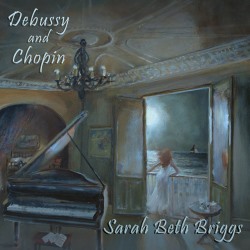
Support us financially by purchasing
this through MusicWeb
from £10.45 postage paid world-wide.
 |
Claude DEBUSSY (1862-1918)
Suite Bergamasque, L82 [19:09]
Pour le piano, L95 [14:21]
Frédéric CHOPIN (1810-1849)
Ballade No. 1 in G minor, Op. 23 [9:52]
Berceuse in D flat major, Op. 57 [5:10]
Fantasie in F minor, Op. 49 [13:32]
Scherzo No. 4 in E major, Op. 55 [12:06]
Sarah Beth Briggs (piano)
rec. 16-18 September 2014, Potton Hall, Suffolk, England
SEMAPHORE SMLMP49 [74:38]
Despite having several highly regarded discs under her belt, this is my first encounter with this York-based pianist. She studied with the late Denis Matthews, and later with the Chilean pianist Edith Fischer, who was a pupil of Arrau. A BBC Young Musician of the Year finalist at the age of eleven, she was later a joint winner of the International Mozart Competition in Salzburg. As well as forging a solo career, she has made many forays into the chamber music arena. She also teaches and gives master-classes.
It seems very fitting that Sarah Beth Briggs has chosen two composers who she likes to pair together in her recitals. Debussy’s admiration for the Polish composer was echoed in his view that Chopin was ‘the greatest of all. For with the piano alone he discovered everything’. The CD features four popular works by Chopin, book-ended by two highly contrasting Debussy suites.
The pianist has chosen the First Ballade and the Fourth Scherzo. As she rightly points out in her booklet contribution, these works can and often do stand alone in recital. Their separate opus numbers give an indication that the composer did not necessarily intend them to be played as part of their respective sets. Each is an individual entity. What draws me to her Chopin is that it is controlled, not overtly romanticized and, at times, even rather understated. In the Ballade there is heart-warming sensitivity, with poetic feeling alongside impassioned virtuosity, when called for. It is a truly epic performance. The same attributes can be found in the Fourth Scherzo, which is the sunniest and most temperamentally calm of the four. Briggs establishes the mood and character right from the beginning with those five unison notes, a foretaste of what is to come. The central section, based on a Polish folk song, is eloquent in its realization.
The Berceuse is without doubt one of the highlights; one which she describes as ‘one of the small gems of the piano repertoire’. Here, it is a true lullaby, gentle, lyrical and well-paced. Briggs achieves a diaphanous pearl-like tone and, with sensitive application of pedal, confers a myriad of tonal colours on each successive variation. Despite the left-hand metric regularity, there is no hint of monotony. This is without doubt one of the finest interpretations of this late piece that I have ever heard.
Briggs considers the Fantasie in F minor, Op. 49 ‘the greatest of Chopin’s standalone works’, a sentiment I don’t happen to share. That accolade I would attribute to the Fourth Ballade. Nevertheless, she delivers a compelling performance in which she traverses the changing moods of the evolving narrative with a formidable virtuosity and intellectual vigour. I love the poetic insights she brings to the Lento sostenuto section at 7:58 (bar 199), with exquisite voicing of chords and a wonderful sense of line.
She certainly seems at home and in her comfort zone in the two Debussy Suites. She savours the music, with well judged tempi, dynamics and phrasing. In the ubiquitous Clair de Lune from Suite Bergamasque the clarity of pedaling allows the lush harmonies to emerge with luminosity. In Pour le Piano she summons up all the virtuosity at her disposal to meet the technical challenges head-on. The fleet, well-controlled finger-work in the Toccata is impressive. Both Suites are informed by consummate musicianship, resourcefulness and imagination.
Although traversing a well-trodden path of core repertoire, this CD demonstrates her sheer talent and artistry. The detail, intelligence, freshness and spontaneity this pianist brings to these scores is a delight. These readings stand proud with some of the best. The Potton Hall acoustic is ideal in every way, with plenty of air around the sound. The full, rich tone of the Steinway is captured admirably by the engineers. The booklet notes, in English only, include a portrait of the artist. Her insightful annotations on the works are enlightening.
One final thought. I love Paul Martinez-Frias's imaginative painted image which adorns the booklet. I presume that it depicts the pianist looking out to sea.
Stephen Greenbank
|
